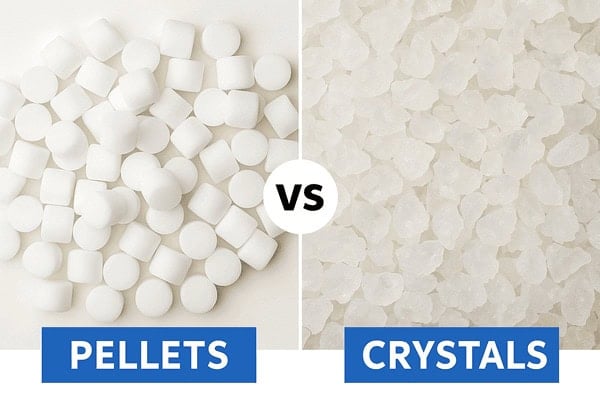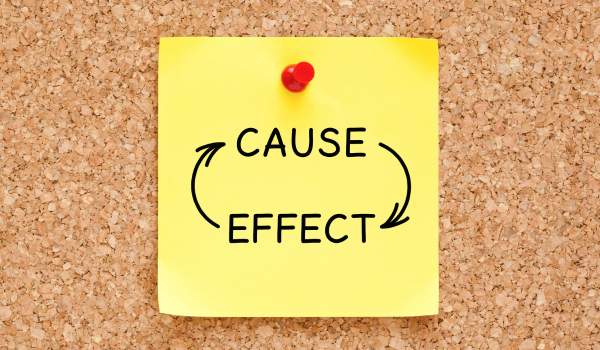💡 Quick Answer: Pellets dissolve more consistently, reducing clog risks in high-flow systems, while crystals are cheaper but can harden, causing salt bridges in older tanks.
Ever stood in the hardware aisle staring at bags of water softener salt, wondering which one won’t brick up your tank? You’re not alone. Let’s unpack what each one actually does — and why picking the right one matters. Choosing the wrong type can gum up your tank, clog the resin bed, and waste money.
🔍 Key Takeaways:
- 🧊 Crystals vs. Pellets: Why one dissolves slower but costs less — and when to use each.
- 🛠️ Maintenance Impact: How salt type affects resin health, bridging, and flow.
- 🌱 Eco & Cost Considerations: Hidden costs and environmental trade-offs you might not expect.
- 🚧 Switching Between Types: The right way to swap salt types without causing mush or clogs.
🤔 What’s the Difference Between Pellets and Crystals?

Think all water softener salt is the same? Not quite. Crystals and pellets may both soften water, but they handle specific conditions differently. Grab the wrong type, and you could end up with clogs, resin fouling, or a tank full of mush.
| Type | 💧 Best For | 🛠️ Pros | 🚧 Cons |
|---|---|---|---|
| 🧊 Crystals | Older systems, well water | Cheaper, slower dissolving, less mush | Hardens easily, can clog resin |
| 🪨 Pellets | High-flow systems, municipal water | Uniform size, fewer clogs, even dissolving | Costs more, can create slush if overfilled |
📌 Take Note: Crystals can harden and form salt bridges in older systems, blocking water flow. Pellets dissolve more evenly but can turn to mush if overfilled.
👉 Time for an upgrade? If your system’s tired and old, check out our top water softeners here.
🛠️ When to Choose Pellets vs. Crystals

Not all water softeners are built the same — and neither is the salt you use. Some systems thrive on pellets, while others get jammed up with anything but crystals. Here’s how to choose the right type based on your system and water conditions:
| Scenario | 🤔 When to Use Crystals | 🪨 When to Use Pellets |
|---|---|---|
| 💧 Older Systems (5+ Years) | Less aggressive on older resin beds, but can clump and bridge. | Dissolves evenly, less clumping. Flush tank before switching. |
| 🚿 Well Water / High Iron | Cheaper, but iron buildup can solidify crystals over time. | Prevents iron fouling in resin. Consider a pre-filter. |
| ⏳ Frequent Regeneration | Slower to dissolve, may leave behind residue in high-use systems. | More consistent, prevents bridging. Ideal for heavy use. |
| ⚠️ Salt Bridging | Prone to hardening, forming solid chunks that cut off flow. | Less bridging, but can leave a mushy residue. |
💡 Pro Tip: If your brine tank is packed with salt bridges, switch to pellets and cut your dosage by 10% for the first month to avoid over-salting the resin.
💡 Are You Using the Wrong Salt?

If your softener is acting up — clogging, regenerating too often, or leaving spots on dishes — your salt might be the culprit. Here’s how to spot the warning signs and what to do about them:
🤔 Salt Bridges
What to Look For: Water flow slows down, and a hardened layer of salt forms on top of loose crystals.
- Crystals: More prone to forming bridges, especially in older systems or those with inconsistent water use.
- Pellets: Less likely to form bridges but can still compact into mush.
Fix: Break up the salt bridge with a broom handle or hot water flush. Switching to pellets can prevent future clogs.
⚡ Resin Fouling
What to Look For: Water feels hard even after regeneration. Resin bed looks slimy or gummed up.
- Crystals: Dissolve unevenly, leaving undissolved chunks that can compact resin beads.
- Pellets: Dissolve more consistently, but can leave mushy buildup if overfilled.
Fix: Flush the resin bed with a resin cleaner. If fouling keeps happening, switch to pellets for more even dissolution.
💧 Salt Mushing
What to Look For: A thick, slushy layer of salt at the bottom of the brine tank. This can block water flow and reduce salt efficiency.
- Crystals: Less likely to mush but can harden into solid chunks.
- Pellets: More likely to form mush if overfilled or exposed to moisture.
Fix: Scoop out the mush, clean the tank, and refill with fresh pellets. Use a salt grid to keep salt elevated above standing water.
⏳ Excessive Regeneration
What to Look For: The system regenerates more than once a week, burning through salt faster than usual.
- Crystals: Slow to dissolve, leading to incomplete regen cycles.
- Pellets: Dissolve quickly but can compact if overfilled.
Fix: Check salt levels and resin bed. If the system struggles to dissolve crystals, switch to pellets to reduce regen frequency.
📌 Something to Know: If your softener is regenerating too often or not enough, it might not be a salt issue. Check for clogged resin beads, low water pressure, or a stuck float valve before making the switch.
🌱 Environmental Impact & Cost

Pellets and crystals don’t just affect your water softener — they impact your wallet and the environment too. Here’s a breakdown of how each salt type stacks up in terms of cost, waste, and sustainability:
💵 Cost Breakdown:
- Crystals: Cheaper upfront but may lead to higher maintenance costs if they harden or form salt bridges.
- Pellets: Higher cost per bag but more consistent dissolution can prevent clogs and resin fouling, reducing long-term repair costs.
🌱 Environmental Impact:
- Crystals: Use less water during regeneration cycles, but their tendency to form hard clumps can lead to more frequent cleanouts and wasted salt.
- Pellets: Dissolve more evenly, reducing salt discharge into septic systems, but they also use slightly more water per cycle.
⚠️ Potential Risks:
- Septic Systems: Excess salt discharge can upset the bacterial balance in septic tanks. Opt for pellets to minimize residue buildup.
- Salt Discharge Regulations: Some regions restrict the amount of salt that can be discharged into municipal systems. Check local guidelines before choosing.
📌 Something to Know: On a septic system? Pellets can reduce the risk of salt buildup, but opt for a lower-sodium formula to minimize the impact on your tank.
💧 Choosing Salt Based on System Type: Upflow vs. Downflow

Not all water softeners handle salt the same way. Upflow and downflow systems have different flow patterns, and choosing the wrong salt type can throw off their performance. Learn more about the key differences here.
🌊 Downflow Systems:
- How They Work: Water flows top-down, compacting the resin bed.
- Best Salt Type: Crystals. They dissolve slower, preventing salt mush in older tanks.
- Watch Out For: Salt bridges. Crystals can harden into solid chunks, cutting off flow.
🌀 Upflow Systems:
- How They Work: Water flows bottom-up, reducing salt compaction.
- Best Salt Type: Pellets. They dissolve evenly, minimizing the risk of resin fouling.
- Watch Out For: Salt mush. Pellets can turn into a slushy mess if overfilled.
⚡ Choosing the Right Salt for Your System:
- If you’re switching from crystals to pellets: Flush the brine tank and cut back on salt dosage for the first month to avoid resin fouling.
- If you’re switching from pellets to crystals: Monitor for bridging, especially in older tanks. Crystals can harden quickly if not dissolved completely.
📌 Something to Know: Not sure which flow type you have? Upflow systems typically use less salt per regen cycle, while downflow systems are more prone to bridging due to compacted resin beds.
🔄 How to Switch from Pellets to Crystals (Or Vice Versa)

Thinking of making the switch? Changing salt types isn’t just a matter of dumping a new bag in the brine tank. If you don’t prep your system right, you could end up with clogs, mushy residue, or salt bridges.
Before you start, check the manufacturer’s guidelines. Some systems are optimized for a specific salt type, and switching could impact performance or void your warranty.
🪨 Switching from Crystals to Pellets:
- Empty the Brine Tank: Scoop out any remaining crystals and discard them.
- Flush the Tank: Rinse with hot water to clear out hardened salt or mushy residue.
- Inspect the Resin Bed: Check for compacted salt at the bottom. If found, break it up manually or with a tank cleaner.
- Add New Pellets: Start with a half-bag to see how your system responds.
- Monitor Flow: Keep an eye on water pressure and check for any signs of mush forming.
💡 Pro Tip: Reduce your salt dosage by about 10% for the first month to help the resin bed adjust.
🧊 Switching from Pellets to Crystals:
- Clean Out the Brine Tank: Remove any mush or leftover pellet residue.
- Run a Manual Regeneration: This clears out residual salt from the resin bed.
- Add Crystals: Start with a smaller amount to see if bridging occurs.
- Watch for Clogs: Check flow rates regularly, especially during the first few cycles.
- Adjust Salt Settings: Crystals dissolve slower, so increase the cycle time slightly if your water still feels hard.
📌 Take Note: Switching to crystals? Plan for more frequent tank inspections to break up any salt bridges before they become a problem.
⚠️ What to Watch Out For:
- Sudden Drop in Flow: Could mean salt clumping in the tank.
- Hard Water Spots: Indicates the salt isn’t dissolving properly.
- Gritty Residue in Fixtures: Crystals may be dissolving unevenly.
🧐 Heads Up: Whenever you switch types, expect a short adjustment period as the system recalibrates. Monitor water quality and pressure to catch any issues early.
✅ Final Thoughts
Choosing the right salt type isn’t just about the price tag — it’s about how your system handles it. If you’re running a high-efficiency or newer upflow system, pellets are your best bet for even dissolution and fewer clogs. But if your tank’s been around the block or you’re dealing with frequent salt bridges, crystals can still do the job — just be ready to scoop out the occasional salt chunk.
💧 Key Takeaways:
- For Older Systems: Crystals are budget-friendly but can harden and bridge, especially in well water systems.
- For High-Efficiency Systems: Pellets dissolve more evenly, preventing resin fouling and flow issues.
- Switching Types? Prep the tank, adjust salt dosage, and monitor for bridging or mush.
💡 Pro Tip: Before making a final call, run a quick water test to see what’s actually in your water. High iron, sediment, or heavy mineral content can all impact how your salt dissolves and how often you need to regenerate.
 151 people found this helpful. Was this guide helpful to you?
151 people found this helpful. Was this guide helpful to you? 

